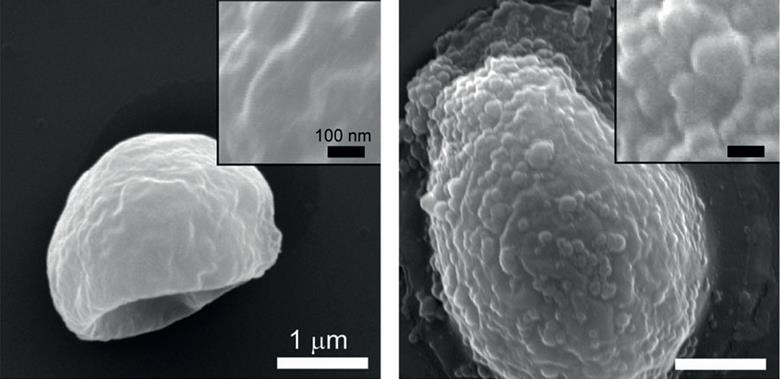Dec 2 2016
Living cells have been given the ability to grow their own protective polymer coats. Such polymer coats could allow for new cell–polymer hybrids with unique surface properties and interactions not found in nature, which could be useful in cell therapy, biocatalysis and biomachines.
 Scanning electron microscopy images of normal yeast (left) and the polymer-coated yeast (right) (Source: © Wiley-VCH)
Scanning electron microscopy images of normal yeast (left) and the polymer-coated yeast (right) (Source: © Wiley-VCH)
Polymers have been grafted onto cell surfaces before, including covalent linking of polymers and layer-by-layer polymer deposition. But Insung Choi at the Korea Advanced Institute of Science and Technology and colleagues say their method is the first time that polymers have been grown or grafted from the surfaces of living cells. ‘Compared with grafting-to approaches, our grafting-from approach enables the tight control over chemical manipulation including polymer density, polymer length and chemical compositions, which makes it possible to tune the physicochemical and biological properties of cell surfaces with ease,’ explains Choi.
The polymerisation technique employs a new kind of atom transfer radical polymerisation (ATRP) which is less toxic to cells. The method doesn’t grow polymers directly from cell surfaces, however. Rather, they form on a polydopamine layer, which the researchers primed the individual yeast cells with. This layer was crucial for initiating polymerisation with water-soluble and biocompatible sodium methacrylate monomers. What’s more the polydopamine provided essential protection for the cells by blocking deadly radicals produced during polymerisation.
‘We were somewhat surprised that the simple introduction of the protective polydopamine layer with a thickness of just 10nm really reduced the cytotoxicity of polymerisation,’ says Choi. Thirty minutes of polymerisation was required to generate a dense polymer covering on cells after which cell viability went from 82% to 67%, compared with 91% to 32% for a non-polydopamine primed control. Choi thinks cell viability can be improved further with faster and milder polymerisation conditions.
‘The results demonstrate the power of ATRP applied to biological systems,’ says polymer chemist Krzysztof Matyjaszewski at Carnegie Mellon University, US, who developed ATRP. ‘They clearly showed retained viability of cells, post-polymerisation functionalisation and demonstrated that the grafted polymer could prevent agglutination of the yeast. This illustrates the possibility of making new complex bioconjugates beyond simple proteins, nucleic acids and carbohydrates.’
However, Choi acknowledges that they cannot yet grow polymers from the surfaces of mammalian cells – which would be needed for biomedical applications – because the polydopamine priming step kills these cells. ‘We are currently working on the development of methods for grafting polymers from mammalian cells without significant loss of cell viability.’